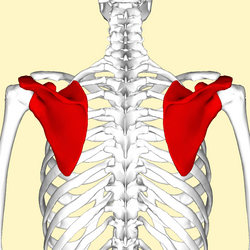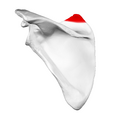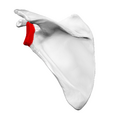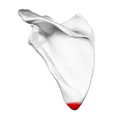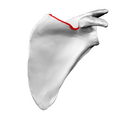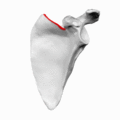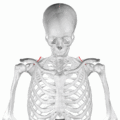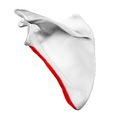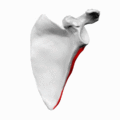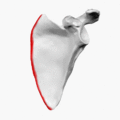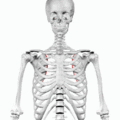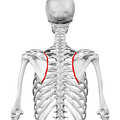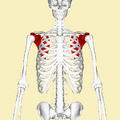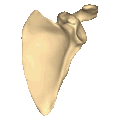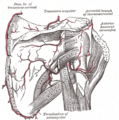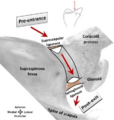| Bone: Scapula |
|
|
|
|
| The upper picture is an anterior (from the front) view of the thorax and shoulder girdle. The lower picture is a posterior (from the rear) view of the thorax (scapula shown in red.) |
| Latin |
Scapula
(omo) |
The scapula is a special bone in your body. You might know it better as your shoulder blade. It's also called the shoulder bone, wing bone, or blade bone. This important bone connects your humerus (which is your upper arm bone) to your clavicle (which is your collar bone).
You have two scapulae, one on each side of your body. They are like mirror images of each other. This means they look the same but are on opposite sides. The word "scapula" comes from ancient Roman times. People thought the bone looked like a small shovel or a tool called a trowel.
Sometimes, in medical words, you might see "omo-" at the beginning of a word. This prefix means "shoulder blade." It comes from an old Greek word for shoulder.
Your scapula is part of your shoulder girdle, which is like a bony ring that supports your arm. In people, the scapula is a flat bone. It's shaped a bit like a triangle. You can find it on the back and side of your rib cage.
Images for kids
-
3D model of the scapula, showing its different parts.
-
Figure 5: How the scapula bone forms from seven centers.
-
A winged scapula (left). This happens when the scapula sticks out.
-
Left scapula, front view. The anatomic neck is red, and the surgical neck is purple.
-
-
The top corner (superior angle) shown in red.
-
The side corner (lateral angle) shown in red.
-
Anatomic neck (red) and Surgical neck (purple).
-
The bottom corner (inferior angle) shown in red.
-
The front surface of the left scapula. The top edge (superior border) is shown in red.
-
Left scapula. The top edge (superior border) shown in red in an animation.
-
Animation. The top edge (superior border) shown in red.
-
The back surface of the left scapula. The side edge (lateral border) shown in red.
-
Left scapula. The side edge (lateral border) shown in red in an animation.
-
Animation. The side edge (lateral border) shown in red.
-
Left scapula. The inner edge (medial border) shown in red in an animation.
-
Animation. The inner edge (medial border) shown in red.
-
Still image. The inner edge (medial border) shown in red.
-
The Levator scapulae muscle (red). This muscle helps move the scapula.
-
The Rhomboid minor muscle (red). This muscle helps pull the scapula towards the spine.
-
The Rhomboid major muscle (red). This muscle also helps pull the scapula towards the spine.
-
The position of the scapula (shown in red). Animation.
-
The shape of the scapula (left). Animation.
-
The chest area seen from behind.
-
The arteries around the scapula and shoulder.
-
Left scapula. Back surface. The top edge is labeled.
-
Scapula. View from the inside.
-
-
A computer-generated image of the scapula turning around.
-
The path of the suprascapular canal.
See also
 In Spanish: Escápula para niños
In Spanish: Escápula para niños
 In Spanish: Escápula para niños
In Spanish: Escápula para niños


